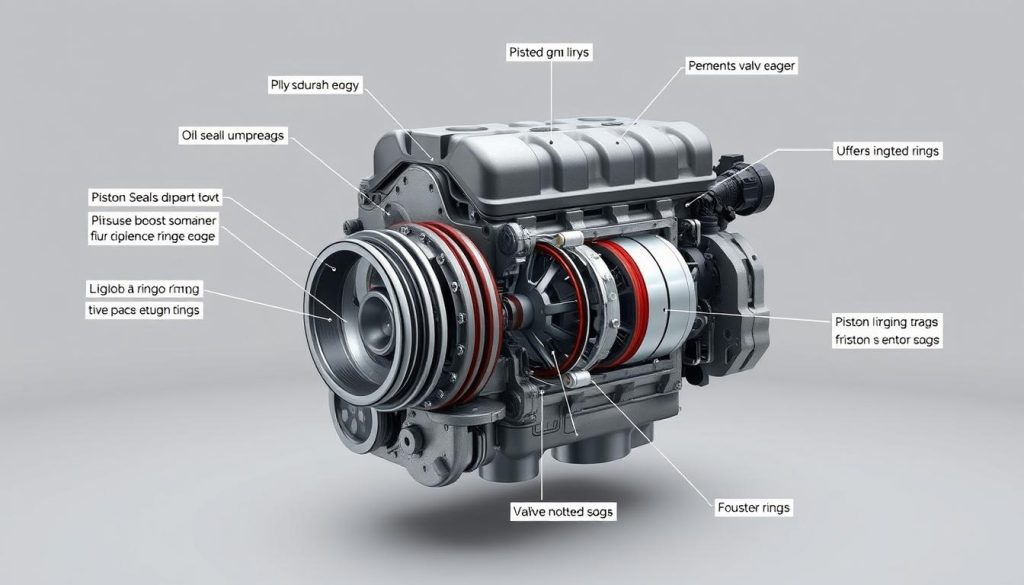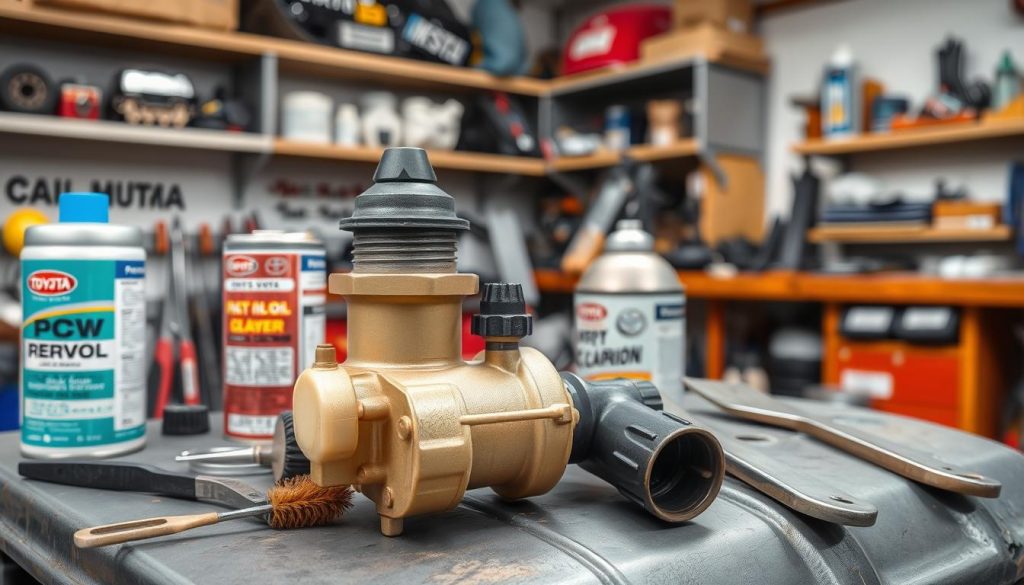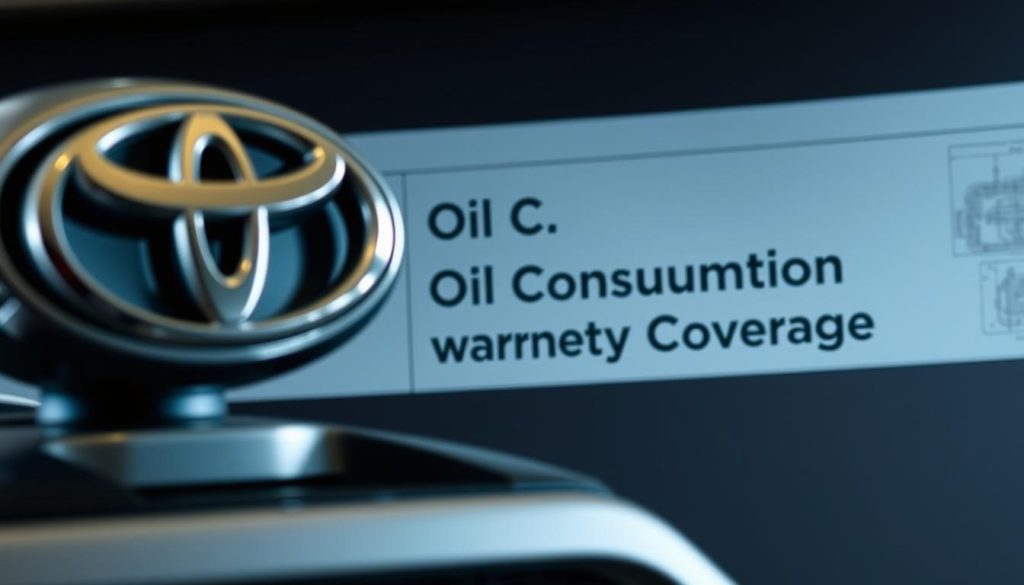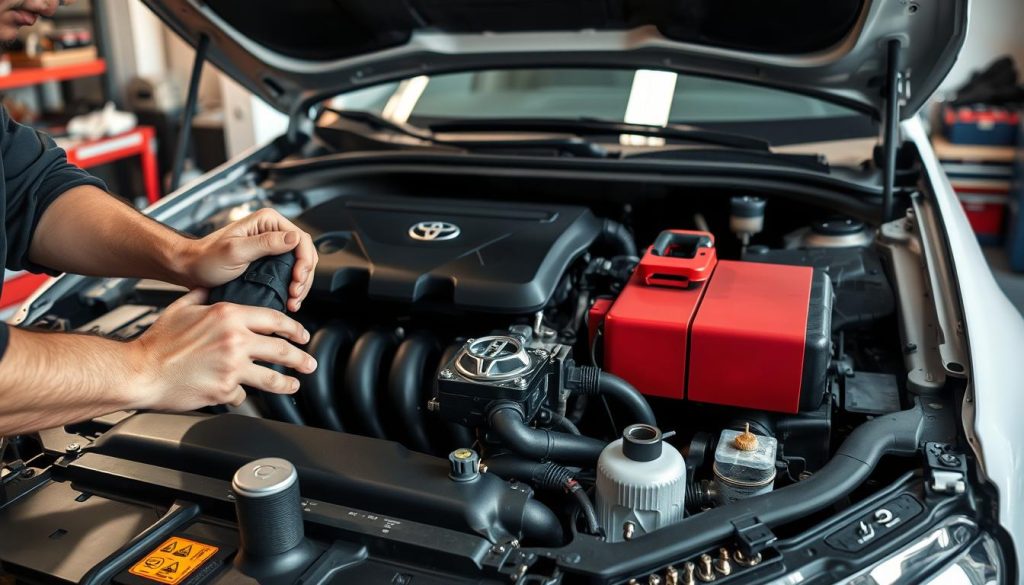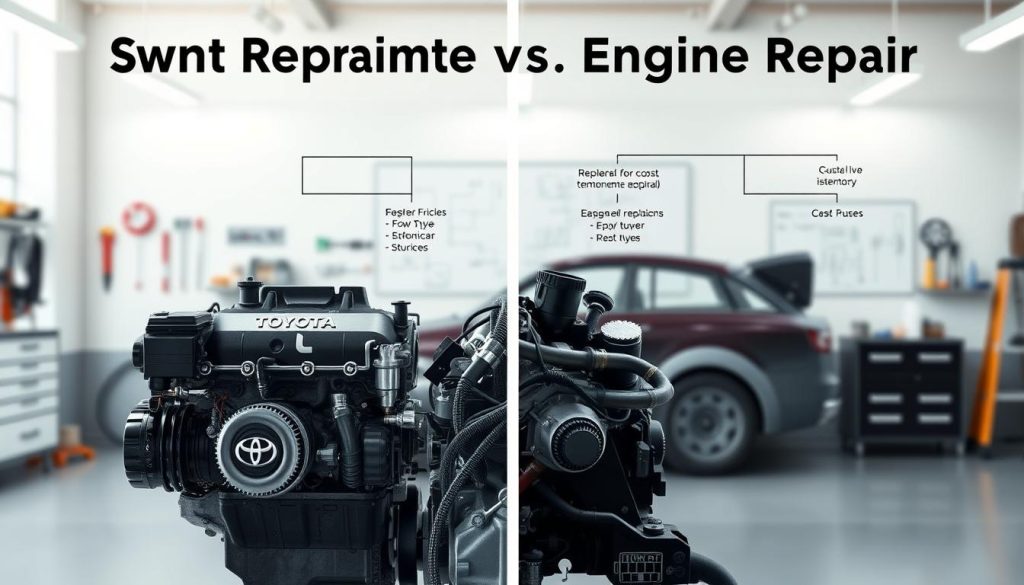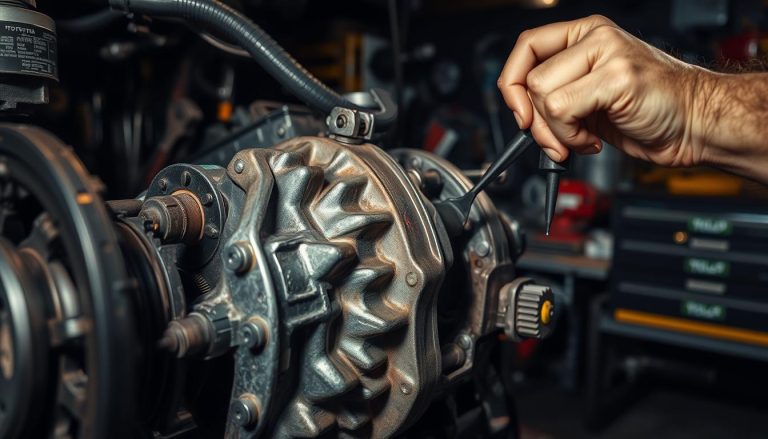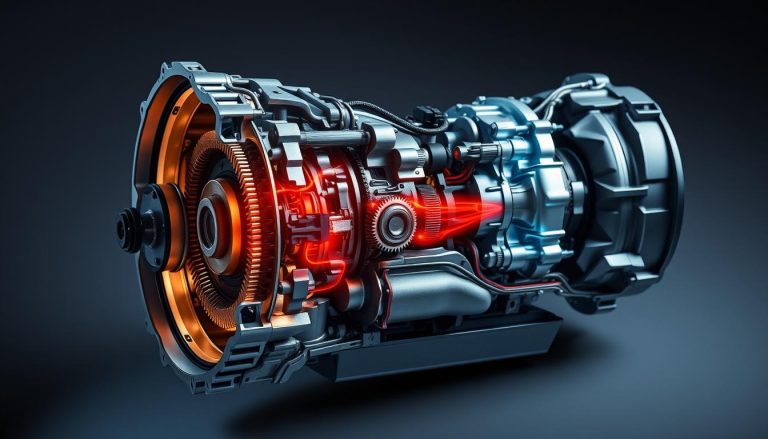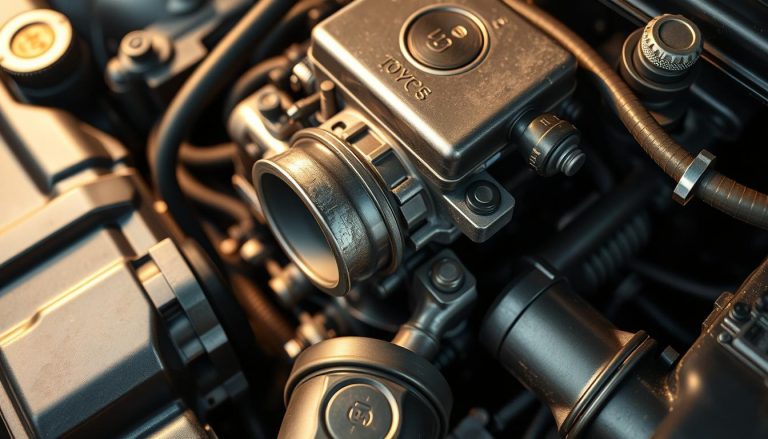Why Toyota Oil Consumption Happens: Causes and Fixes
If your car is using oil too fast, it’s a big problem. Many drivers find they need to add oil often, even when it’s not time for a check-up. This issue is a big worry for thousands of car owners in the U.S.
Models made between 2007 and 2011 were hit hard. Excessive oil consumption became a big worry for many families. Cars with the 2.4L 2AZ-FE engine were the worst affected.
Knowing why this happens is key to protecting your car. Engine damage can be very expensive if not fixed. Problems range from bad piston rings to carbon buildup in the engine.
But, there are solutions for every budget and skill level. Simple fixes can solve minor problems, while serious cases need professional help. Whether you drive a Camry, RAV4, or Corolla, catching the problem early saves money and prevents big breakdowns.
Key Takeaways
- Models from 2007-2011 with 2.4L engines face the highest risk of oil burning issues
- Early detection prevents costly engine damage and expensive repairs
- Multiple solutions exist, from simple DIY fixes to professional overhauls
- Faulty piston rings and carbon buildup are the primary causes
- Regular monitoring helps catch problems before they become severe
- Popular models like Camry, RAV4, and Corolla are most commonly affected
Understanding Oil Consumption in Toyota Vehicles
Knowing how your Toyota uses motor oil is key to spotting problems early. Motor oil is vital for keeping engine parts running smoothly. It prevents damage from friction and heat.
Every engine loses some oil as it runs. This is called normal oil consumption. Your Toyota is built to handle this oil loss without trouble.
Normal oil consumption lets you drive longer without needing to add oil. Most Toyotas can go 5,000 to 10,000 miles without needing extra oil.
Excessive engine oil consumption is a big problem if your car uses oil too fast. If you’re adding a quart or more every 1,000 miles, it’s a sign of trouble.
Healthy engines have oil flowing through set paths to lubricate parts. But when Toyota oil problems arise, oil leaks past worn seals and rings.
This oil then burns in the combustion chamber, not doing its job. It gets used up as exhaust, wearing down engine parts.
Spotting oil consumption issues early can save you a lot of money. It can prevent expensive repairs and engine failure.
Knowing your Toyota’s oil use helps you care for it better. Keep track of oil additions to find out your car’s normal oil use.
Recognizing the Warning Signs of Excessive Oil Burning
Your Toyota will show you signs when it burns too much oil. Spotting these oil consumption symptoms early can save your engine from costly damage. Many Toyota owners miss these signs until the damage is severe and expensive.
Protecting your engine starts with regular checks and quick action. Your car shows signs through visual cues and changes in how it runs. By noticing these signs, you can fix problems before they get worse.
Visual Indicators to Watch For
The most clear sign of oil burning is blue smoke from your exhaust. This blue smoke is most noticeable when you start the car or accelerate hard. Unlike white smoke from coolant or black smoke from fuel, blue smoke means oil is burning.
Check your oil dipstick often to see if oil levels are dropping. If oil levels fall too fast before your next oil change, your engine is burning oil. A healthy engine keeps oil levels steady between changes.
Your dashboard might show an oil level warning or oil change reminder sooner than usual. Instead of the usual 5,000 to 10,000 miles, you might see these alerts at 3,000 miles or less. This means your engine is burning oil faster than it should.
Look for oil spots or stains under your car. While leaks from outside are different from burning oil inside, they both lead to oil loss. Fresh oil is amber or black, while older oil is darker and thicker.
Performance-Related Symptoms
Engine noises can tell you a lot about oil consumption. Listen for ticking, tapping, or rattling sounds when the engine is low on oil. These sounds mean parts are not getting enough lubrication and need attention right away.
Your Toyota might idle roughly or run unevenly. Oil-soaked spark plugs can’t ignite fuel well, causing misfires and power loss. You might feel hesitation when accelerating or notice the engine isn’t running as well as it should.
Notice if your car emits more exhaust than usual. Beyond the blue smoke, you might smell burning oil from the exhaust. This smell gets stronger during long drives or when going uphill.
Engine knock or pinging sounds when you accelerate mean your engine isn’t getting enough oil. These sounds happen when parts don’t have enough oil to protect them. Ignoring these oil consumption symptoms can cause serious engine damage and cost a lot to fix.
Toyota Models Most Affected by Oil Consumption Issues
Some Toyota models burn more oil than others. This problem is not found in all Toyotas. But, certain model years and engine types show a pattern of oil burning.
The Toyota models affected are mainly from 2007 to 2011. Some issues also appear in earlier and later years. These cars have engines that lead to oil burning.
“The 2AZ-FE engine was designed for fuel efficiency, but its low-tension piston rings created an unintended consequence of increased oil consumption in many vehicles.”
Camry and Corolla Oil Consumption Problems
Toyota Camry oil consumption issues are common in 2007-2011 models. These cars often have the 2.4-liter 2AZ-FE engine.
The Corolla also has problems from 2007-2009. It uses the same engine as the Camry, focusing on fuel economy over oil retention.
Matrix models from 2007-2009 have the same engine as the Corolla. Owners often report burning more than one quart of oil per 1,000 miles.
RAV4 and Highlander Known Issues
RAV4 oil burning problems are seen in 2007-2011 models with the 2AZ-FE engine. Many drivers of this popular SUV face these issues.
Highlander models from 2007-2010 also have oil consumption issues. Both four-cylinder and V6 engines are affected, with the 2.4-liter and 2.5-liter engines showing the most problems.
Avalon and Solara vehicles from 2005-2010 also have oil burning tendencies. Even V6 engines in these models can develop consumption issues over time.
Prius and Hybrid Model Considerations
Prius and other hybrid models use different engines, reducing oil consumption risks. The hybrid system’s operation patterns create less stress on engine components.
Yet, hybrid vehicles are not completely immune to oil burning problems. Regular monitoring remains important even for these more efficient powertrains.
Scion tC models from 2007-2009 are also on the list. These sporty coupes have the same 2AZ-FE engine as other problematic Toyota models.
Knowing your vehicle’s model year and engine type helps understand your risk. If you own any of these Toyota models affected by oil consumption issues, it’s key to watch oil levels closely for engine protection.
Root Causes Behind Toyota Oil Consumption
Toyota’s oil consumption issues come from mechanical failures in key engine systems. These problems don’t happen overnight but gradually worsen with miles. Understanding these root causes helps you make informed decisions about repairs and maintenance strategies.
The main culprits behind excessive oil burning involve three interconnected systems. Each plays a critical role in keeping engine oil where it belongs. When one fails, it often creates a domino effect that accelerates oil consumption.
Worn Piston Rings and Cylinder Walls
The primary villain in Toyota’s oil consumption saga is the low-tension piston ring design. Toyota engineered these rings to reduce friction and boost fuel economy. But, this design choice had an unexpected trade-off.
These piston rings act more like sieves than proper seals in affected engines. Carbon buildup accumulates behind the oil control rings, jamming them so they can’t scrape oil off cylinder walls effectively. This allows oil to sneak past and burn in the combustion chamber.
The problem gets worse over time. As carbon deposits increase, the rings lose their ability to maintain proper compression. Your engine starts burning oil at an alarming rate, sometimes requiring frequent top-offs between oil changes.
Valve Seal Deterioration
Valve seals represent another common failure point, often seen in higher-mileage Toyota vehicles. These small but critical components prevent oil from the valve train area from entering the combustion chamber.
Age and heat cycles cause these seals to harden and crack. Once they lose their flexibility, oil begins seeping past them during engine operation. You’ll often notice this as blue smoke during startup or acceleration.
The deterioration process accelerates when drivers extend oil change intervals beyond recommendations. Old, contaminated oil breaks down these rubber seals faster than fresh lubricant.
PCV System Malfunction
The Positive Crankcase Ventilation system plays a supporting role in oil consumption problems. When the PCV system malfunctions, it creates excessive vacuum that pulls oil past seals and rings.
A clogged PCV valve can’t regulate crankcase pressure properly. This imbalance forces oil through any available pathway, including past worn piston rings and deteriorating valve seals.
“The perfect storm for excessive oil consumption occurs when these three systems fail simultaneously, combined with extended oil change intervals and sometimes thin synthetic oils.”
Regular maintenance can prevent some of these issues, but Toyota’s design choices made certain problems almost inevitable in affected models. The next step involves learning how to diagnose which specific components are causing your oil consumption problems.
How to Diagnose Oil Consumption in Your Toyota
Before you spend money on repairs, find out how much oil your Toyota burns. Proper oil consumption diagnosis saves you money and shows how serious the problem is. It helps you know if it’s just a small issue or something big.
Start by measuring the oil level. This takes time but gives you important information. Accurate diagnosis is your roadmap to cost-effective solutions.
Monitor Oil Levels Over Time
Fill your engine oil to the right level. Reset your trip odometer and drive 1,000 miles normally. Then, check the oil level again.
If you lose more than one quart, your Toyota has a big oil consumption problem. Normal oil consumption is less than one quart per 1,000 miles. Take photos of the dipstick readings for later.
Do this test twice to make sure. Weather and driving habits can change oil consumption, so be consistent.
Check for External Leaks
Park your Toyota on clean pavement or cardboard overnight. Look for oil spots or puddles under the engine in the morning. Oil leak detection helps find out if it’s internal burning or an external leak.
Look at the engine parts for oil residue. Check the oil pan gasket, valve cover gaskets, and oil filter housing. External leaks and internal oil burning have different signs.
Clean any oil residue and watch these areas for new leaks. This step helps rule out external causes before looking at internal problems.
Perform a Compression Test
A compression test checks your piston rings and cylinder walls. Remove spark plugs and disable the fuel system. Put the compression gauge in each cylinder and crank the engine a few times.
Write down the compression readings for all cylinders. Healthy engines have similar pressure, usually between 140-180 PSI. Low pressure in one or more cylinders means wear that causes oil consumption.
Compare your results to Toyota’s specs for your engine model. Big differences between cylinders might mean piston ring problems.
Inspect the PCV System
Take out the PCV valve and shake it gently. A good valve rattles when shaken. A silent PCV valve needs to be replaced right away.
Check PCV hoses for damage or blockages. Look at the air intake system for oil residue, which means PCV system problems. A bad PCV system can really increase oil consumption.
Use an OBD2 scanner to find misfire codes and freeze frame data. These codes often go with oil consumption issues and give more clues about engine health. Modern scanners find problems that you might miss by just looking.
Engine Design Factors Contributing to Oil Burning
Toyota aimed to improve fuel economy in the mid-2000s. They made changes to meet emissions standards and boost gas mileage. These choices led to long-term reliability issues for many owners.
The company wanted to reduce internal friction and increase efficiency. These efforts made engines more efficient but also prone to oil consumption problems. Knowing these design factors helps explain why some Toyotas burn more oil than others.
Low-Tension Piston Ring Design
Low-tension piston rings were a key change for Toyota. They reduce friction against cylinder walls, improving fuel economy and emissions. But, this design has a drawback.
Low-tension piston rings don’t seal as well as high-tension ones. Over time, carbon deposits make sealing even worse. This leads to oil leaking into the combustion chamber.
As engines get older, these rings can get stuck. Carbon buildup prevents them from moving properly. This allows oil to leak into the combustion chamber, a big problem for high-mileage engines or those with poor maintenance.
“The low-tension ring design was an engineering decision that prioritized short-term fuel economy gains over long-term oil retention capabilities.”
Engine Oil Specifications and Viscosity
Toyota now uses thinner synthetic oil in their engines. They prefer 0W-20 or 5W-20 oil viscosity. This thinner oil flows better in cold weather and helps with fuel economy.
The problem is that thin oil can slip past worn or stuck piston rings. This doesn’t mean the oil is bad. It’s just thinner than thicker conventional oils.
Switching to thicker oils like 5W-30 can help with oil consumption. But, this might void the warranty and affect fuel economy. The real fix is to address the ring sealing issues, not just change the oil type.
Oil viscosity is very important for high-mileage Toyotas. Following the manufacturer’s specs is key for warranty purposes. But, knowing how different viscosities work with worn engine parts helps owners make better maintenance choices.
Step-by-Step Guide to Fix Minor Oil Consumption
Before spending a lot on engine repairs, try some simple fixes. These can help a lot with oil consumption in your Toyota. They tackle issues like stuck piston rings and bad ventilation systems. Many people see big improvements after a few hundred miles.
Start with the easiest fixes first. These work best for cars with a bit of oil consumption, not a lot. Combining different fixes works best than just one.
Replace PCV Valve and Hoses
Replacing the PCV valve is a cheap first step. It controls how the engine breathes and stops oil from leaking. A bad PCV valve can cause a lot of oil burning, but it’s only $10-$30.
Find the PCV valve on your engine’s valve cover. Pull it out or unscrew it, depending on your Toyota. Check the rubber hoses for damage or oil leaks.
Put in the new PCV valve and fix any bad hoses. The valve should rattle when shaken. Test it by removing the oil cap while the engine runs – you should feel a slight pull.
Use High-Mileage Oil Treatment
High-mileage oil treatments help older engines use less oil. Products like Sea Foam and Marvel Mystery Oil make seals work better and piston rings move freely. They take a few oil changes to work fully.
Follow the directions on the bottle to add the treatment to your oil. Don’t add too much because it can make the oil too thin. Drive for at least 500 miles to let it work.
Keep an eye on your oil use while using the treatment. Many Toyota owners see a 20-40% drop in oil use. Results depend on your engine and how many miles it has.
Clean Carbon Deposits
Carbon cleaning gets rid of deposits that make piston rings stick and use more oil. It involves chemical treatments and driving methods to burn off carbon. Regular cleaning keeps rings from getting stuck.
Use a good fuel system cleaner every 3,000 miles to clean intake valves and chambers. Sea Foam can be added to the fuel tank or intake manifold for deeper cleaning. Always follow safety rules when using cleaning chemicals.
The “Italian tune-up” method involves driving fast on the highway when the engine is hot. This burns off carbon naturally through high heat.
| Treatment Method | Cost Range | Expected Results | Time to See Improvement |
|---|---|---|---|
| PCV Valve Replacement | $10-$30 | 10-30% reduction | Immediate to 100 miles |
| High-Mileage Oil Treatment | $15-$25 | 20-40% reduction | 500-1,000 miles |
| Carbon Cleaning Products | $12-$20 | 15-25% reduction | 300-500 miles |
| Combined Approach | $40-$75 | 40-60% reduction | 1,000-1,500 miles |
These minor fixes work best together as a full maintenance plan. Keep track of your oil use before and after to see how well they work. They might not fix very worn engines, but they can help a lot with moderate oil use.
Remember, it takes time to see results. Give each treatment at least 1,000 miles to work fully. If these fixes don’t help enough, you might need more serious repairs.
Professional Repair Solutions for Severe Cases
Severe oil burning problems in Toyota vehicles often need professional repair solutions. When simple fixes and regular maintenance don’t work, it’s time for major engine repairs. These repairs help your engine keep the right oil levels and work well.
Professional mechanics have three main ways to fix serious oil consumption issues. Each method is different in complexity, cost, and how well it works. The best choice depends on your vehicle’s specific problems and condition.
Ring Replacement Process
Piston ring replacement is a common fix for severe oil burning. This process involves taking the engine apart to get to the pistons inside the cylinders. Mechanics must remove the engine, take off the cylinder head, and pull out each piston one by one.
The process includes honing cylinder walls to prepare them for new rings. Each ring is fitted with the right gap to seal properly. Replacing piston rings costs between $1,500 and $3,500, while doing it yourself can cost $300 to $600 in parts alone.
This repair needs special tools and a lot of mechanical knowledge. It’s important to follow the right torque and assembly steps for success.
Seal Replacement Options
Valve seal replacement is a less invasive alternative for oil consumption through valve guides. This method focuses on the cylinder head area without removing the engine. Some skilled shops can replace valve seals with the engine in place.
The process involves removing the cylinder head and taking apart the valve train. New seals stop oil from leaking into the combustion chambers. Replacing valve seals costs less than piston work but needs professional skills.
Complete Rebuild Considerations
An engine rebuild is needed when many parts show wear or damage. This approach fixes worn cylinder walls, damaged pistons, and deteriorated seals at once. A rebuild gives your engine a new life with better oil consumption.
Professional rebuilds include machining, new gaskets, and updated parts. While it’s pricey, it’s the best fix for high-mileage engines with many problems.
| Repair Type | Cost Range | Labor Time | Warranty Period |
|---|---|---|---|
| Piston Ring Replacement | $1,500-$3,500 | 15-25 hours | 12-24 months |
| Valve Seal Replacement | $800-$2,200 | 8-15 hours | 12 months |
| Engine Rebuild | $3,000-$6,000 | 25-40 hours | 24-36 months |
| DIY Ring Replacement | $300-$600 | Weekend project | No warranty |
Choose experienced shops with good reputations for major engine work. Get multiple quotes and make sure warranties are offered for all professional repairs. The precision and care in these solutions are key to their success.
Toyota’s Official Response and Warranty Coverage
Toyota has taken big steps to fix oil consumption problems. They recognized some models burned oil too fast. They offered help to owners of these vehicles.
Toyota didn’t ignore customer worries. They set up detailed checks and fixes. This shows they care about fixing problems and keeping customers happy.
Technical Service Bulletins
Technical Service Bulletins are official messages from Toyota to dealerships. They give detailed checks and fixes for oil issues.
Each TSB lists the vehicles affected by oil problems. Dealers use this info to see if a vehicle is covered under warranty. They also know how to fix it right.
The bulletins also have rules for testing oil use. This helps techs see if a car uses too much oil. If it does, they can fix it.
Extended Warranty Programs
Toyota started warranty extension programs. These programs cover more than the usual warranty. They can last up to 10 years or 150,000 miles for oil-related engine repairs.
These programs cover important parts like piston rings and valve seals. Toyota warranty under these programs can save owners a lot of money.
Even if a vehicle is past its usual warranty, it might be covered. Toyota’s customer service can check if a vehicle is eligible.
| Program Type | Coverage Period | Components Covered | Eligibility Requirements |
|---|---|---|---|
| Standard Warranty | 3 years/36,000 miles | Engine defects | All new vehicles |
| Powertrain Warranty | 5 years/60,000 miles | Engine internals | Original owner |
| Extended Oil Consumption | 10 years/150,000 miles | Piston rings, valve seals | Specific VIN ranges |
| Goodwill Repairs | Case-by-case basis | Engine components | Documented maintenance |
Keeping records is key for warranty claims. Keep track of oil bought, how much used, and maintenance done. This helps prove you’ve taken good care of your car.
To check your warranty, contact Toyota customer service or visit a dealership. Many owners get coverage even after their warranty ends. This is often because they have good records of oil use and maintenance.
Comprehensive Cost Analysis of Different Repair Options
Fixing Toyota oil consumption issues can cost a lot, depending on how you choose to fix it. Knowing these costs helps you decide whether to repair your car or get a new one.
Fixing your car yourself can save a lot of money. Simple repairs might cost $20 in parts but $200 at a shop.
DIY Repair Costs
Doing repairs yourself can save a lot if you know how and have the right tools. Oil additives and engine flushes cost $10 to $30 and are the cheapest way to start fixing minor oil consumption.
Replacing the PCV valve costs $10 to $30 for the part. Most Toyota owners can do this simple swap with basic tools.
Spark plug replacement costs $20 to $40 for quality plugs. This repair directly addresses oil-fouling symptoms. Replacing the valve cover gasket costs $30 to $60 in parts but saves on labor.
Engine rebuild is the biggest DIY challenge. Parts and machine work cost $300 to $600 if you have the skills and space to do it.
Professional Service Pricing
Professional services add labor costs that can triple the total cost. A valve cover gasket that costs $60 in parts becomes a $100 to $250 repair at most shops.
Simple PCV valve replacement goes from $20 in parts to $80 to $120 installed. Spark plug replacement costs $100 to $150 with labor included.
Engine rebuild is the most expensive professional job. Costs range from $1,500 to $3,500 or more based on location and work needed. Labor rates and parts markup increase these costs.
Cost vs. Vehicle Value Considerations
Repair decisions should balance costs against your Toyota’s value. Spending $3,000 on engine work is worth it for a $8,000 car but not for a $2,000 one.
Think about how much you care about the car and its condition. Sometimes, it’s better to trade it in for someone else to fix it, saving on expensive repairs.
Also, consider your transportation needs and timeline. A $500 temporary fix might give you six months to save for a better car instead of rushing into expensive repairs.
| Repair Type | DIY Cost | Professional Cost | Time Investment |
|---|---|---|---|
| Oil Additive Treatment | $10-$30 | $50-$80 | 15 minutes |
| PCV Valve Replacement | $10-$30 | $80-$120 | 1 hour |
| Valve Cover Gasket | $30-$60 | $100-$250 | 2-3 hours |
| Spark Plug Replacement | $20-$40 | $100-$150 | 1 hour |
| Engine Rebuild | $300-$600 | $1,500-$3,500 | 20-40 hours |
Preventive Maintenance Strategies to Reduce Oil Consumption
Proactive maintenance is key to avoiding expensive oil consumption problems. By following preventive maintenance, your Toyota engine stays efficient and catches issues early. This approach saves money and protects your investment.
Consistency and proven maintenance practices are essential. Regular care ensures your engine runs smoothly. Small steps today prevent big repairs later.
Maintaining Proper Service Schedules
Always follow Toyota’s oil change intervals without skipping. Some think synthetic oil lets them go longer, but it can lead to problems. The 2AZ-FE engine, for example, needs frequent oil changes.
Check your oil level at every gas station stop. This simple habit helps catch problems early. Early detection can save you from costly repairs.
Regular maintenance also lets your technician check for leaks. They can spot issues during routine visits. This saves thousands in repairs.
Following Factory Oil Requirements
Only use recommended oil specifications for your Toyota. Using the wrong oil might seem like a good idea, but it can cause more problems. Thicker oils might seem to help but can hurt fuel economy and cold-weather performance.
Toyota engineers picked specific oil viscosity ratings for your engine’s protection. These specs balance lubrication and flow. Trust the engineering and avoid experimenting.
Choose quality oil brands that meet Toyota’s standards. Avoid cheap oils that may not keep viscosity under stress. Your engine’s life depends on consistent lubrication quality.
Adopting Engine-Friendly Driving Practices
Your driving habits affect oil consumption. Short trips prevent engines from reaching full temperature, leading to carbon buildup. Try to include longer drives in your errands.
Driving on highways helps burn off deposits and keeps components clean. Sustained temperatures allow engines to self-clean. Regular highway miles are part of your maintenance routine.
Avoid idling too long, as it promotes carbon buildup without cleaning benefits. Modern engines don’t need long warm-ups. Start driving gently after 30 seconds of idling.
| Maintenance Strategy | Frequency | Cost Range | Prevention Benefit |
|---|---|---|---|
| Oil Changes | Every 5,000 miles | $30-60 | Prevents sludge buildup |
| Oil Level Checks | Weekly | Free | Early problem detection |
| PCV System Inspection | Every 30,000 miles | $50-100 | Maintains proper ventilation |
| Fuel System Cleaning | Every 15,000 miles | $80-150 | Reduces carbon deposits |
Use quality fuel and add fuel system cleaners to your tank occasionally. Clean combustion chambers reduce carbon formation that leads to oil consumption. Prevention costs less than fixing problems later.
Watch how your engine performs in different driving conditions. Notice if consumption goes up in certain situations. This helps you adjust your driving to reduce oil burning.
Preventive maintenance is most effective as a complete system. Combining proper oil change intervals, correct specifications, and smart driving habits is the best defense against consumption issues. Your Toyota will thank you with reliable, efficient performance for years.
When to Consider Engine Replacement vs. Repair
Deciding whether to fix your engine or replace your car is tough. It depends on money and practicality. Severe oil issues can lead to expensive fixes. Understanding the key factors helps make a smart choice.
Your Toyota’s condition is key. If it’s old and has other problems, fixing the engine might not be worth it. Think about if other parts like the brakes or suspension need work soon.
Mileage and Age Factors
Mileage and age are primary indicators for repair or replacement. Cars with over 200,000 miles face different costs than newer ones with the same issues.
A 2010 Toyota Camry with 150,000 miles might be cheaper to fix than the same model with 250,000 miles. Higher mileage often means multiple systems are approaching failure points. This can lead to a chain of problems when fixing one issue.
- Vehicles under 100,000 miles: Repairs often worthwhile
- 100,000-200,000 miles: Evaluate total vehicle condition
- Over 200,000 miles: Consider replacement more seriously
- Age over 15 years: Factor in obsolescence issues
Older cars also have part availability issues. Discontinued components or expensive dealer-only parts can be a problem. Labor costs remain the same for all ages, making repairs more expensive on older cars.
Cost-Benefit Analysis
Do a cost-benefit analysis by comparing repair costs to your car’s value. Include both immediate and future costs.
First, find out your Toyota’s current trade-in and private sale values. If repair costs exceed 50% of the vehicle’s value, replacing might be better. But, this depends on your situation.
Think about these financial points in your analysis:
- Total repair costs including parts, labor, and taxes
- Estimated reliability after repairs
- Monthly payment differences between repair and replacement
- Insurance cost changes with a newer vehicle
- Fuel economy improvements with replacement
Your needs also matter. If you need maximum reliability for long drives, replacing the engine might be better. But, if the Toyota is a backup, living with oil consumption might be okay.
Remember, your time and stress are important too. Ongoing car troubles can affect your life quality. Sometimes, the emotional cost of dealing with issues is more than the financial cost.
Alternative Solutions and Temporary Workarounds
When big repairs aren’t an option, smart Toyota owners look for other ways to keep their cars running. They find ways to handle oil use without spending a lot on engine work. The key is staying proactive instead of waiting for problems to happen.
Many drivers keep their Toyotas running longer by watching oil levels closely and making small changes. These steps won’t stop oil use, but they help manage it for a long time.
Oil Consumption Monitoring Systems
Today’s oil monitoring systems make it easy to track your Toyota’s oil use. They help you know when to add more oil and avoid running low.
Many Toyotas come with built-in systems that show oil life on your dashboard. Check your owner’s manual to see if your car has this feature.
For older Toyotas, there are aftermarket systems that offer similar benefits. These include:
- Digital oil level sensors that alert you when levels drop
- Smartphone apps that track consumption over time
- Simple dipstick reminder systems you can set yourself
Keep track of your oil use in a notebook or app. Note the date, mileage, and amount added. This helps you predict when you’ll need more oil and spot any sudden changes.
Temporary Fixes for High-Mileage Vehicles
For high-mileage cars, the focus is on slowing oil use, not stopping it. These quick fixes can extend your Toyota’s life without a big investment.
Switching to slightly thicker oil often helps in older engines. If your manual allows, try moving from 0W-20 to 5W-30. The thicker oil seals better.
High-mileage oil has additives that reduce leaks and burning. These oils cost more but can save money in the long run.
Find a routine that fits your driving style for checking oil. Many check oil at every gas fill-up or weekly, whichever comes first. Consistency is more important than frequency when it comes to monitoring.
Always have emergency supplies in your car. Keep one quart of the right oil in your trunk or cargo area. This simple step prevents being stranded with low oil.
The goal isn’t to fix the problem permanently, but to manage it safely while you decide on long-term solutions.
These quick fixes work best with good driving habits. Avoid sudden acceleration and high RPMs when you can. Gentle driving reduces wear on the engine and slows oil use.
Conclusion
Toyota offers many solutions for oil consumption, from simple fixes to major repairs. These options fit different budgets and situations. The 2005-2011 models with 2.4L engines often face these issues, but regular maintenance can prevent many problems.
Begin with basic fixes like replacing the PCV valve or using high-mileage oil. These cost between $10 to $50 and fix many small problems. Also, check your oil levels weekly to spot issues early.
For bigger repairs, like replacing piston rings, the cost can be $3,500 or more. Compare this to your car’s value. Sometimes, spending on professional repairs is worth it for newer cars with less mileage.
Check with Toyota dealerships about warranty extensions or technical service bulletins for your model year. Many owners get help through these programs.
Regular oil changes with the right viscosity protect your engine. Drive carefully during warm-up and avoid short trips when you can.
Your Toyota can last many years with the right care. Fix oil consumption issues early to avoid expensive engine damage. Keep records of oil usage and maintenance to see improvements after repairs.
FAQ
What is considered normal vs. excessive oil consumption in Toyota vehicles?
Normal oil use lets you go between oil changes without adding oil. Excessive use means adding a quart or more every 1,000 miles. This happens when oil leaks past worn seals and gets burned in the engine.
Which Toyota models are most affected by oil consumption problems?
The 2007-2011 Camry and Corolla with the 2.4L 2AZ-FE engine are notorious oil burners. The RAV4 and Highlander from the same years also have this issue. Even some V6 engines in Avalon and Highlander can be affected, but the 2AZ-FE is the main problem.
What are the main warning signs that my Toyota is burning oil excessively?
Look for blue smoke from your exhaust, noticeable when starting or accelerating. Check your dipstick often. If oil levels drop a lot between changes, you have a problem. You might also hear unusual engine noises, like ticking or tapping.
What causes Toyota engines to burn oil excessively?
Toyota’s low-tension piston ring design is the main cause. It’s meant to reduce friction but doesn’t seal well, leading to oil burning. Valve seal wear and PCV system issues also cause oil to enter the combustion chamber.
How can I diagnose oil consumption in my Toyota?
First, fill your oil to the right level and reset your trip odometer. Drive 1,000 miles normally and check the oil level again. If you’ve lost more than a quart, you have a problem. Look for leaks, do a compression test, and check the PCV system.
What are some simple fixes I can try before major repairs?
Start with replacing the PCV valve, a – part. High-mileage oil treatments and additives can help piston rings. Cleaning with fuel system cleaners and driving on highways can also help.
Does Toyota provide warranty coverage for oil consumption issues?
Yes, Toyota has issued Technical Service Bulletins and extended warranty coverage for affected vehicles. Extended warranties can cover repairs up to 10 years or 150,000 miles. Contact Toyota customer service or your local dealer to see if your VIN qualifies.
How much does it cost to fix Toyota oil consumption problems?
DIY fixes can cost – for a PCV valve or 0-0 for engine rebuild skills. Professional services cost more, with engine rebuilds ranging from
FAQ
What is considered normal vs. excessive oil consumption in Toyota vehicles?
Normal oil use lets you go between oil changes without adding oil. Excessive use means adding a quart or more every 1,000 miles. This happens when oil leaks past worn seals and gets burned in the engine.
Which Toyota models are most affected by oil consumption problems?
The 2007-2011 Camry and Corolla with the 2.4L 2AZ-FE engine are notorious oil burners. The RAV4 and Highlander from the same years also have this issue. Even some V6 engines in Avalon and Highlander can be affected, but the 2AZ-FE is the main problem.
What are the main warning signs that my Toyota is burning oil excessively?
Look for blue smoke from your exhaust, noticeable when starting or accelerating. Check your dipstick often. If oil levels drop a lot between changes, you have a problem. You might also hear unusual engine noises, like ticking or tapping.
What causes Toyota engines to burn oil excessively?
Toyota’s low-tension piston ring design is the main cause. It’s meant to reduce friction but doesn’t seal well, leading to oil burning. Valve seal wear and PCV system issues also cause oil to enter the combustion chamber.
How can I diagnose oil consumption in my Toyota?
First, fill your oil to the right level and reset your trip odometer. Drive 1,000 miles normally and check the oil level again. If you’ve lost more than a quart, you have a problem. Look for leaks, do a compression test, and check the PCV system.
What are some simple fixes I can try before major repairs?
Start with replacing the PCV valve, a $10-$30 part. High-mileage oil treatments and additives can help piston rings. Cleaning with fuel system cleaners and driving on highways can also help.
Does Toyota provide warranty coverage for oil consumption issues?
Yes, Toyota has issued Technical Service Bulletins and extended warranty coverage for affected vehicles. Extended warranties can cover repairs up to 10 years or 150,000 miles. Contact Toyota customer service or your local dealer to see if your VIN qualifies.
How much does it cost to fix Toyota oil consumption problems?
DIY fixes can cost $10-$30 for a PCV valve or $300-$600 for engine rebuild skills. Professional services cost more, with engine rebuilds ranging from $1,500-$3,500 or more. Consider your vehicle’s value when deciding to repair or replace.
How can I prevent oil consumption issues in my Toyota?
Stick to Toyota’s recommended oil change intervals and use the right oil viscosity. Check your oil level at every gas fill-up. Regular highway driving and quality fuel help keep your engine clean.
When should I consider replacing my Toyota instead of repairing oil consumption issues?
Consider your vehicle’s age and mileage. A 2008 Camry with 200,000 miles is different from one with 100,000 miles. Look at your vehicle’s overall condition and other issues. Compare repair costs to replacement costs and think about your transportation needs.
Can I safely drive my Toyota while it’s consuming oil excessively?
You can manage oil consumption by monitoring oil levels weekly and keeping a quart of correct oil in your vehicle. Consider using slightly thicker oil viscosity. But never let oil levels get too low, as it can damage your engine.
Is it safe to use thicker oil to reduce consumption in my Toyota?
Switching to slightly thicker oil viscosity (like 5W-30 instead of 0W-20) can slow consumption. High-mileage oil with seal conditioners can also help. But be careful not to go too far from Toyota’s recommended viscosity, as it might affect fuel economy and cold-weather performance.
,500-,500 or more. Consider your vehicle’s value when deciding to repair or replace.
How can I prevent oil consumption issues in my Toyota?
Stick to Toyota’s recommended oil change intervals and use the right oil viscosity. Check your oil level at every gas fill-up. Regular highway driving and quality fuel help keep your engine clean.
When should I consider replacing my Toyota instead of repairing oil consumption issues?
Consider your vehicle’s age and mileage. A 2008 Camry with 200,000 miles is different from one with 100,000 miles. Look at your vehicle’s overall condition and other issues. Compare repair costs to replacement costs and think about your transportation needs.
Can I safely drive my Toyota while it’s consuming oil excessively?
You can manage oil consumption by monitoring oil levels weekly and keeping a quart of correct oil in your vehicle. Consider using slightly thicker oil viscosity. But never let oil levels get too low, as it can damage your engine.
Is it safe to use thicker oil to reduce consumption in my Toyota?
Switching to slightly thicker oil viscosity (like 5W-30 instead of 0W-20) can slow consumption. High-mileage oil with seal conditioners can also help. But be careful not to go too far from Toyota’s recommended viscosity, as it might affect fuel economy and cold-weather performance.



